- Clone
- 3G8.5 (See other available formats)
- Regulatory Status
- RUO
- Other Names
- Hf, SE1, TSP1, Ctla3, TSP-1, Ctla-3, AW494114
- Isotype
- Mouse IgG2b, κ
- Ave. Rating
- Submit a Review
- Product Citations
- publications
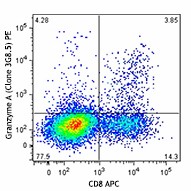
-

CD3/CD28 (three days) stimulated BALB/c splenocytes were intracellularly stained with CD8 APC and granzyme A (clone 3G8.5) PE (top) or mouse IgG2b, κ PE isotype control (bottom). -

| Cat # | Size | Price | Quantity Check Availability | Save | ||
|---|---|---|---|---|---|---|
| 149703 | 25 µg | 123€ | ||||
| 149704 | 100 µg | 278€ | ||||
Granzyme A is a serine protease that is similar to Granzyme B. However, unlike granzyme B, granzyme A is a homodimer. It is expressed in cytotoxic T cells and natural killer cells (NK), but is not essential for induction of apoptosis or DNA fragmentation. Cell death induced by granzyme A is slower and morphologically different than the cell death induced by granzyme B. It plays a crucial role in infection-mediated inflammation as well as immunological responses against viruses, bacteria, and tumor cells.
Product DetailsProduct Details
- Verified Reactivity
- Mouse
- Antibody Type
- Monoclonal
- Host Species
- Mouse
- Immunogen
- Full length recombinant granzyme A of mouse origin.
- Formulation
- Phosphate-buffered solution, pH 7.2, containing 0.09% sodium azide.
- Preparation
- The antibody was purified by affinity chromatography and conjugated with PE under optimal conditions.
- Concentration
- 0.2 mg/ml
- Storage & Handling
- The antibody solution should be stored undiluted between 2°C and 8°C, and protected from prolonged exposure to light. Do not freeze.
- Application
-
ICFC - Quality tested
- Recommended Usage
-
Each lot of this antibody is quality control tested by intracellular immunofluorescent staining with flow cytometric analysis. For flow cytometric staining, the suggested use of this reagent is ≤0.25 µg per million cells in 100 µl volume. It is recommended that the reagent be titrated for optimal performance for each application.
- Excitation Laser
-
Blue Laser (488 nm)
Green Laser (532 nm)/Yellow-Green Laser (561 nm)
-
Application References
(PubMed link indicates BioLegend citation) -
- Fehniger TA, et al. 2007. Immunity 26:798. (ICFC)
- Product Citations
-
- RRID
-
AB_2565309 (BioLegend Cat. No. 149703)
AB_2565309 (BioLegend Cat. No. 149704)
Antigen Details
- Structure
- 29 kD, Homodimer, Serine protease
- Distribution
-
Cytotoxic T cells and natural killer cells (NK); low on granulocytes, B cells, and activated dendritic cells (DCs).
- Function
- Induction of cell death and apoptosis.
- Cell Type
- T cells, NK cells
- Biology Area
- Cell Biology, Immunology, Innate Immunity, Neuroscience
- Molecular Family
- Proteases, Enzymes and Regulators
- Antigen References
-
1. Susanto O, et al. 2013. Cell Death Differ. 20:1183.
2. Ebnet K, et al. 1995. EMBO J. 14:4230.
3. Jenne DE, et al. 1988. Immunol. Rev. 103:53. - Gene ID
- 14938 View all products for this Gene ID
- UniProt
- View information about Granzyme A on UniProt.org
Related FAQs
- What type of PE do you use in your conjugates?
- We use R-PE in our conjugates.
Other Formats
View All Granzyme A Reagents Request Custom Conjugation| Description | Clone | Applications |
|---|---|---|
| Purified anti-mouse Granzyme A | 3G8.5 | ICFC |
| PE anti-mouse Granzyme A | 3G8.5 | ICFC |
Customers Also Purchased
Compare Data Across All Formats
This data display is provided for general comparisons between formats.
Your actual data may vary due to variations in samples, target cells, instruments and their settings, staining conditions, and other factors.
If you need assistance with selecting the best format contact our expert technical support team.
-
Purified anti-mouse Granzyme A

CD3/CD28 (three days) stimulated BALB/c splenocytes were int... 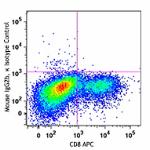
-
PE anti-mouse Granzyme A
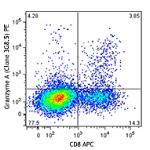
CD3/CD28 (three days) stimulated BALB/c splenocytes were int... 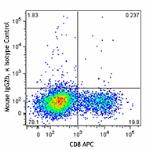
 Login / Register
Login / Register 









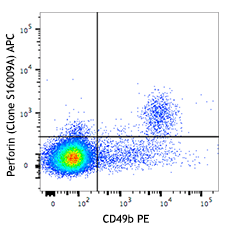

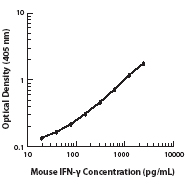




Follow Us